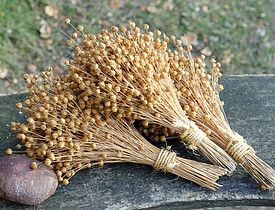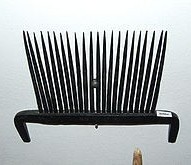Linen fabric is a textile that is made from the fibers of the flax plant. Linen is a natural cellulose fiber and comes from the inside of the stalks of the flax plant. Flax is an annual herb and is grown as a food and also a fiber crop. It is grown in warm moist climates around the world and has been cultivated for more than 6,000 years.
So Where Does Linen Fabric Come From?
Flax that is used for textile production is known as linen in Western countries. The stalks are used making linen fabric, while the seeds are used as a food source and the oil is known as linseed oil.
Flax fiber is extracted from the bast beneath the surface of the stem of the plant. Linen fibers are lustrous, strong and flexible and absorbent. They are stronger and driers quicker than cotton, but are less elastic. To make linen fabric is a laborious process but it produces a textile that is cool and fresh to wear in hot and humid climates.

Flax Cultivation
Flax is grown like a grain crop with many plants growing close together. Farming flax requires few pesticides and fertilizers. Plants can grow 10 to 15 centimeters in height after 8 weeks of sowing. It grows several centimeters per day and can reach 70 to 80 centimeters within 50 days.
Each plant makes one or more erect, slender stems with small blue and white flowers near the top of the stems. The plant flowers for three to four weeks, but each flower lasts for less than a day.

For fiber production flax is harvested after about 100 days when the stems are about meter high. This is approximately a month after flowering and two weeks after the seeds form. It is best to harvest when the base of the plants start turning yellow, as the fiber will be underdeveloped and the seeds not useful if the plant is still green. Once the plant turns brown, the fiber will degrade.
Harvesting Of Flax For Linen Fabric
Harvesting can be either mechanical or manual.
1.Mechanical: A combine harvester is used to cut either the whole plant or just the heads to then extract the seeds. When harvesting flax for linen fabric, a specialized flax harvester is used to harvest the plants. It looks a bit like a combine harvester, but it has a flax puller rather than a cutting head. So the plants are pulled out of the ground instead of cutting them.

To avoid getting grass and weeds in the flax, the plants are turned and gripped by belts about 20 to 25 centimeters off the ground. The belts then pull the entire plant out the ground so that the roots can also be used and therefore have longer fibers. The plants are passed over the harvester and left in the field for retting.
2. Manual: instead of cutting the flax plants, they are pulled up by hand with the roots to increase the length of the fibers. Depending on climatic conditions, the plants are left to ret for between two weeks and two months.
Processing Of Flax
In order to retrieve the fibers, the woody stem and inner pith (called pectin), which hold the fibers together in a clump, must be rotted away. Flax that is harvested for seeds go through a process of threshing to remove the seeds from the plants. Here we will be looking at the processes for linen fabric production.

Retting is the process of rotting away the inner stalk while leaving the outer parts intact, so the straw or course outer stem is remaining. There are different methods of retting with pond retting being the fastest but generally believed to produce a low quality. Field retting is considered to provide the highest quality fiber and with the least amount of pollution.
The flax fibers are bound to the straw by pectin. Because of alternating rain and sun during the retting process, an enzymatic action takes place which degrades the pectin and enables the flax fibers to be extracted. The flax fibers must be separated from the stalk before they can be spun into linen.
“Dressing” the flax requires three processes to remove the straw from the fibers.

- Breaking: The usable flax fibers are separated from the stems by pulling the stems through a hackle and / or breaking the plants by beating them. This way the flax is “broken”, breaking the straw into small short bits to remove the straw without harming the long flax fibers.
- Scutching: The process of scraping the outer straw from the fiber is called scutching. The stems are then pulled through hackles.
- Heckling: Hackles are like combs that remove the straw and shorter fibers from the long fibers. A heckle is a bed of nails through which the fibers are passed.
The fibers can then be spun and woven into linen fabric.
Benefits Of Linen Fabric
– Linen is highly absorbent and a good conductor of heat.
– Linen fabric will remove perspiration from the skin quickly, thereby allowing the skin to breathe and air to circulate around the body. This makes it hypoallergenic and suitable for allergy sufferers to use.
– It is naturally antiseptic and kills bacteria and naturally insect repellent.
- – Clothes made from linen fabric provide coolness during hot weather making the wearer more comfortable. When it is cold, pure linen fabric will save natural body heat.
- – Flax fiber is the strongest natural fiber, making linen fabric durable and long-lasting.
- – Linen fabric is biodegradable and recyclable so doesn’t need to go into landfill sites, thus reducing the carbon footprint.
- – Flax plants are resilient and can grow in poor soil requiring very little water.
- – Cultivation of the flax plant is far more sustainable than cotton, putting linen fabric inherently under the label of sustainable fashion.
- – Caring for linen fabric is easy as it can be hand or machine washed. Line dry your linen and ironing it is optional. Linen fabric will become softer with each wash. Linen fabric is renowned for it’s fashionable crumpled look.
Alternative Uses Of Flax:
Linen fabric is widely used for clothing, bed linen, tablecloths, napkins and other household items, but flax also has additional uses:
- As a raw material in high quality paper such as banknotes.
- Laboratory paper like blotting paper and filter papers.
- Paper for rolling cigarettes
- Teabags
Flax straw that has a poor quality and is not good enough for flax fibers for the production of linen fabric, is baled. These can then be sold as bio fuel or used to build shelters for farm animals.
Almost all of the flax plant can be used. With the increased demand in the health food sector for flax seeds and linseed oil, there is even less that goes to waste.
Check out AROLORA Dairy Linen Collection made by 100% Linen.
-------------------------------------------------------------------------------------------------
The article is written by at ecoworldline.





